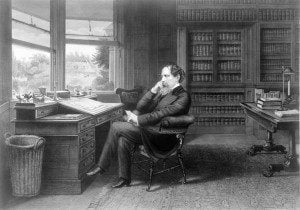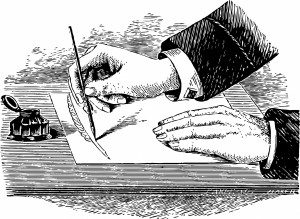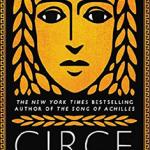
It’s National Novel Writing Month again tomorrow! You would think that a Pagan would be more concerned with Samhain (and I am doing a private ritual tonight, after I hand out Halloween candy at my work dressed as Wonder Woman), but I look forward to NaNoWriMo every year. November in the BC Interior is dark, rainy, muddy, cold and generally ugly. Since I suffer from Seasonal Affective Disorder it makes me depressed. Immersing myself in my writing is a great way for me not only to cope, but to thrive, and do something that matters to me and my future while I’m at it.
For those who aren’t familiar, the challenge is to write a 50,000 word novel in a month. That sounds crazy, right? But it’s actually only 1667 words a day; if you write every single day. That might still sound intimidating, but the columns I write here at Patheos are usually as long as that, or longer (average about 1750 words). So it’s challenging, especially when keeping up with all my other obligations; but if you’ve always been wanting to write a novel and can’t seem to find the time to write, this is the way to do it. The big thing it gives you, when you’re done, is a formed habit of writing every day (anything done for 21 days becomes a habit; that’s why three weeks is a milestone in the struggle to quit smoking or any other bad habit you want to quit).
I thought that this year I would share some of the process of my journey with my readers. This is what I’ve done so far to prep for NaNoWriMo and what worked for me. If this is something you’ve been considering doing but you wanted to know what was involved first, come see it through my eyes!
Step 1: Sign Up
The very first step is to sign up at their website. You create a user account just like any other forum or social media platform. I know people who have done NaNo as a personal challenge because they didn’t want to sign up unless they were sure that they could do it, but with one exception, they have never finished the goal. Going through the sign up process is a signal to your subconscious that you really mean to do this, and that extra step of commitment often makes the difference.
Signing up can be done all year round but you usually don’t get a lot of benefit from it until at least September. I signed up in the first week of October this year and that worked well for me, because it allowed me to participate in the prep events and there was enough going on to keep me involved.

Step 2: Create Your Novel
What do you want to write? This is the place to think about it! Do yourself a favour; even if you don’t know for sure, come up with something to fill this gap, no matter how vague. It will help you to crystalize your ideas later on, or make you realize before you’ve put a single word down that you’re not really in to that idea after all. Chances are, though, if this is your first time, you’ve got at least one idea thumping around on the inside of your skull that you’ve just got to get out! So go with that one, even if it’s Twilight fanfic or clown slasher fiction or soft core porn. Just do it! Much of your success at NaNo will depend on a “damn the torpedoes” kind of personal bravery. That’s what writing is about.
Step 3: Try to Identify Your Writing Style
NaNo participants have a cultural lingo for this. We call it “Plotters” or “Pantsers.” Plotters need to do all the things they told you to do in writing class; have an outline, do a character tree, write details about your setting in a notebook, thoroughly research your subject matter before you write anything so you sound like you know what you’re talking about. If you’re a Plotter, signing up before November is extremely helpful, because there are hundreds of resources out there that you can look through to help you with this process, and doing it before November starts gives you extra time to prepare instead of taking up important writing time. That being said, I don’t think you should let that discourage you from participating even at this point if you’re a Plotter; you’re just going to need to spend a little more time on it (and if you’re like me, having an excuse to spend more time on writing is a good thing.
Pantsers do better flying by the seat of their pants. They would rather just start writing without any clear idea of where they’re going. Too much plotting would just create an unnecessary straightjacket that would force the story to conform to artificial standards. This kind of person tends to do really well at improv or English essays on tests. I would suggest you still come up with a basic title and brief plot description so you have something to aim at, but have at it.
This year the NaNo people finally added a category that people have been talking about on the forums for a few years; the Plantser. That’s me. A Plantser needs a general outline and some relevant information; maybe a clear idea of the world or protagonist. I’ve usually got a couple of important scenes in my head, like the charms on a charm bracelet, and I’ll come up with the connecting beads to complete the pattern as I go. If I don’t spend at least a little time making this clear in my head, I run into problems; but if I overplan I constrict myself to the point where the story can’t move. Last year I almost didn’t finish because my story idea wasn’t clear enough when I began, so at times I was flounding. I still did it, though; and later on in the month I’ll share some tips about how to get through the difficult times when the mind draws a blank. NaNo’s got stuff for that too.
Step 4: Make Some Friends
Is there a local NaNoWriMo group? You find out by going to the Regional Forums and seeing if there might be something close to you. Last year the NaNo people finally found that there were enough people in the Okanagan Valley to give us our own regional forum, and a Municipal Liaison (who is kind of like a team cheerleader and office manager), but we’ve had a small group in my town that’s been writing for years. One of them I even knew from the local Pagan community; another is my nephew’s grandmother. You never know who else might be an aspiring novelist!
Can’t find people near you? That’s okay. NaNo also has a variety of forums that are specific to genre or that deal with specific writing issues. Most of them have at least one thread that’s about finding writing buddies. Adding them is more or less just like adding a friend on Facebook, and they can choose to add you back or not. This year, since I am writing hard science fiction for the first time (I usually do soft sci-fi or fantasy); I was delighted to connect with not one, but two astrophysicists in the Science Fiction forum who are willing to vet my work for accuracy.
Step 5: Prepare Your Friends and Family
Let’s face it; this is going to take a lot of time out of your day you’re not used to giving. Let your friends and family know that this is something you’re going to do and why it’s important to you. Since you can’t stay home from work because you’re writing a novel (most employers tend to frown on that) it’s the family and friend time that’s likely to suffer. Sometimes they’re supportive and sometimes they’re not. Be a little selfish if this matters to you and do it anyway. How are you ever going to achieve your dream otherwise? But be willing to try to address their concerns and meet them halfway when you can. Ask for help if you need it.
Step 6: Announce Your Novel!
Okay, you’re committed now. So let the world know! If you proclaim your intentions publicly, you are far more likely to succeed. Also, you’ve have extra people supporting you, and that can’t hurt. Besides, you get a self-awarded Participation Badge for doing it. (See “My NaNoWriMo” tab for more info).
Also, if you or a friend have any graphic editing capability, create a cover image for your novel and upload it to the site. They say that you are 60% more likely to finish that way.
Step 7: Do Your Prep Research
Sometimes you need to know things before you start. So now’s the time to do that research. Last year I wrote a fantasy novel about a character whose gender had been magically transformed. So I asked questions of my friends who were trans and I watched YouTube videos and read a lot of literature on the subject. It took place in a medieval culture so I read about horses and medieval combat strategy. In the years before I was writing about a special forces trained soldier so I learned some basic martial arts combat to understand the physics better for my fight scenes. This year is probably the most research I’ve ever done; I needed to research asteroid mining, the Oort Cloud, geology, and because my character is Indo-Canadian, I am now researching the Sikh faith.
Don’t worry if you don’t get all this done! You don’t have to be this thorough. And you can always edit for content (which means fact and research checking) when November is over. Don’t let it stop you if you didn’t get to this step.
Step 8: Participate in a Prep Event
The best part about NaNo is that you’re not doing it alone, and all kinds of resources exist to support you. Get involved in a local or online prep event so that you can socialize with others and they can help cheer you on (and you can do the same for them). You might have one in your local area (your local forum is the place to find out) or you can join any number of Facebook, Twitter, or YouTube livestream events. It helps to get you psyched up and ready to write! Your local prep event might even offer you fun starter kits with stickers and pens and calendars and things; or you might be eligible for fun prizes.

Step 9: Prepare Your Materials
It probably goes without saying, but make sure your computer is in good working order, or buy a new notebook and good pens. Make sure any books you might need to consult are close to hand. And make sure you have data storage devices handy. Nothing beats the heartache of losing a whole chapter because you forgot to back it up! (Trust me, I know from experience). And apply this to old-fashioned pen and paper too. Photocopy your pages. Trust me; what if you spill coffee all over it? You’ll never forgive yourself (yes, I know from experience here too; I didn’t always have a good computer, you know).
And double check that sound equipment if you, like me, like to write to a soundtrack (which you should be preparing right about now).
Step 10: Prepare Your Space
Where are you going to write? The kitchen table? Make sure it’s clean and it doesn’t have food spilled all over it. The local coffee shop? Make sure you have a Starbucks budget. Your office? Clean it and make it friendly; you’re going to be spending a lot of time there. Will surrounding yourself with pictures of your protagonist and maps of your fantasy world help inspire you? Then find them, draw them, print them, and put them up. The act of doing all this is, again, one more sign to yourself of your commitment, and the more committed you are, the more likely you are to succeed at the goal.
Hopefully these tips will help you to clear a path to your writing success. Good luck!
Ready…set…WRITE!
Like Between the Shadows on Facebook and never miss a post!
















